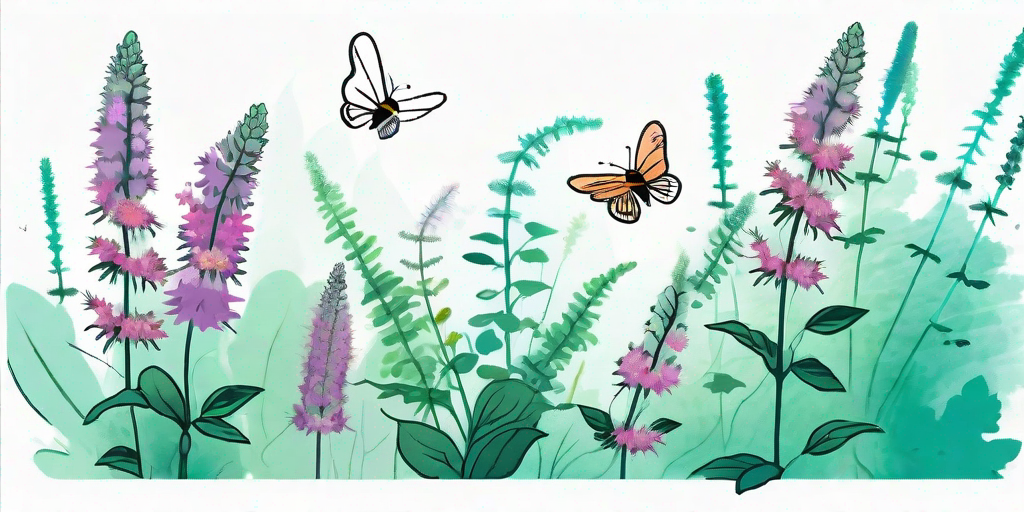
If you're looking to turn your garden into a buzzing paradise for bees and butterflies, then it's time to get acquainted with Agastache. This plant, also known as the Hummingbird Mint, is a sweet nectar powerhouse that will have your garden buzzing with life in no time. So, let's dive right in and explore the world of Agastache.
Understanding Agastache
What is Agastache?
Agastache is a genus of perennial plants that belong to the mint family. Known for their aromatic leaves and tubular flowers, these plants are native to North America. They are hardy, drought-tolerant, and come in a variety of colors, making them a popular choice for gardeners.
But what really sets Agastache apart is its ability to attract pollinators. The nectar-rich flowers are a favorite of bees, butterflies, and hummingbirds, earning it the nickname 'Hummingbird Mint'.
Types of Agastache
There are about 30 species of Agastache, but a few are particularly popular among gardeners. Agastache foeniculum, or Anise Hyssop, is loved for its anise-scented leaves and purple flowers. Agastache rupestris, known as Sunset Hyssop, boasts orange flowers with a root beer-like fragrance. Agastache 'Blue Fortune' is a hybrid with large, blue flowers that are a hit with bees and butterflies.
Each type has its own unique characteristics, but all are excellent for attracting pollinators to your garden.
Planting and Caring for Agastache
How to Plant Agastache
Planting Agastache is a breeze. These plants prefer well-drained soil and full sun, but they can tolerate partial shade. They're also not picky about soil pH, making them a versatile choice for any garden.
Start by digging a hole that's about twice the width of your plant's root ball. Place the plant in the hole, making sure the top of the root ball is level with the soil surface. Backfill the hole, firm the soil gently, and water thoroughly.
Caring for Your Agastache
Once established, Agastache is relatively low-maintenance. Water regularly during the first growing season to establish a deep, extensive root system. After that, they're quite drought-tolerant.
Pruning isn't necessary, but you can cut back the plants in late winter to encourage bushier growth. And while Agastache isn't a heavy feeder, a light application of compost in spring can give them a boost.
Why Bees and Butterflies Love Agastache
The Sweet Nectar
Agastache's nectar-rich flowers are like a five-star restaurant for bees and butterflies. The nectar provides these pollinators with the energy they need to continue their important work.
And it's not just the quantity of nectar that's important. Agastache's nectar is also high in sugar content, making it particularly appealing to bees and butterflies.
The Colorful Flowers
Bees and butterflies are also attracted to the bright colors of Agastache flowers. Bees are particularly drawn to blue, purple, and yellow flowers, while butterflies prefer red, orange, and yellow. With Agastache's variety of flower colors, you're sure to attract a diverse crowd of pollinators.
Plus, Agastache blooms from mid-summer to fall, providing a steady source of nectar when many other plants have finished blooming.
FAQs About Agastache
Is Agastache deer resistant?
Yes, Agastache is generally deer resistant. The aromatic leaves are not to their taste, making it a good choice for gardens with deer problems.
Can Agastache be grown in containers?
Absolutely! Agastache can be grown in containers, making it a great option for balcony gardens or small spaces. Just make sure the container has good drainage.
Does Agastache come back every year?
Yes, Agastache is a perennial plant, meaning it comes back year after year. However, some varieties are more hardy than others, so check the hardiness zone for your specific type.
Conclusion
So, there you have it! Agastache is a versatile, low-maintenance plant that's a magnet for bees and butterflies. By planting Agastache in your garden, you're not only adding beauty and fragrance, but you're also supporting these important pollinators. Now that's something to buzz about!











